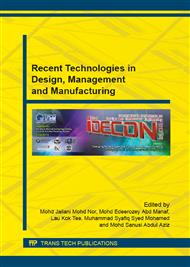[1]
J.K. Liker, Introduction: bringing lean back to the U.S. A, in: Liker, J.K. (Ed. ), Becoming Lean, Inside Storied of U.S. Manufacturers. Productivity Press, Portland, 1998, pp.3-40.
DOI: 10.4324/9781482293661-1
Google Scholar
[2]
R.W. Hall, Lean, and the Toyota Production System. Target. 20 (2004) 27.
Google Scholar
[3]
J. Bicheno, The Lean Toolbox. 2nd ed. PICSIE Books, Buckingham, UK, (2000).
Google Scholar
[4]
R. Shah, P.T. Ward, Defining and developing measures of lean production, J. Oper. Manage. 25 (2007) 785-805.
Google Scholar
[5]
F.A. Moayed, R.L. Shell, Comparison and evaluation of maintenance operations in lean versus non-lean production systems. J. Qual. Maintenance Eng. 15(3)(2009) 285–296.
DOI: 10.1108/13552510910983224
Google Scholar
[6]
G. Anand, R. Kodali, Development of a framework for implementation of Lean manufacturing systems. Int. J. Manage. Pract. 4 (2008) 95-116.
Google Scholar
[7]
A. Saptari, W.S. Lai, M.R. Salleh, Jig Design, Assembly line design and work station design and their effect to productivity, Jordan Journal of Mechanical & Industrial Engineering, 5 (2011) 9-16.
Google Scholar
[8]
J. Jamshidi, P.G. Maropoulos, Methodology for High Accuracy Installation of Sustainable Jigs and Fixtures, in: G. Seliger, M.K. Khraisheh, I.S. Jawahir (Eds. ), Advances in Sustainable Manufacturing, Springer, Heidelberg, 2011, pp.149-155.
DOI: 10.1007/978-3-642-20183-7_22
Google Scholar
[9]
M. Jackson, A. Zaman, An analysis of flexible and reconfigurable production systems. an approach to a holistic method for the development of flexibility and reconfigurability, International Journal of Modern Engineering. 9 (2007) 12-25.
Google Scholar
[10]
Z. Bi,S. Lang, and W. Shen, Reconfigurable manufacturing systems: The state of the art, Int. J. Prod. Res. 46 (2007) 967-992.
Google Scholar
[11]
M. Dudek-Burlikowska, D. Szewieczek, The Poka-Yoke method as an improving quality tool of operations in the process. J. Achievements Mat. Manuf. Eng. 36 (2009) 95-102.
Google Scholar
[12]
J. Grout, Mistake-proofing the design of health care processes. Agency for Health Care Research and Quality, (2007).
Google Scholar
[13]
F.E. Plonka, Developing a lean and agile work force. Hum. Factors Ergon. Manuf. Serv. Ind. 7 (1997) 11-27.
Google Scholar
[14]
P. Middleton, Lean software development: Two case studies. Software Qual. J. 9 (2001) 241-52.
Google Scholar


